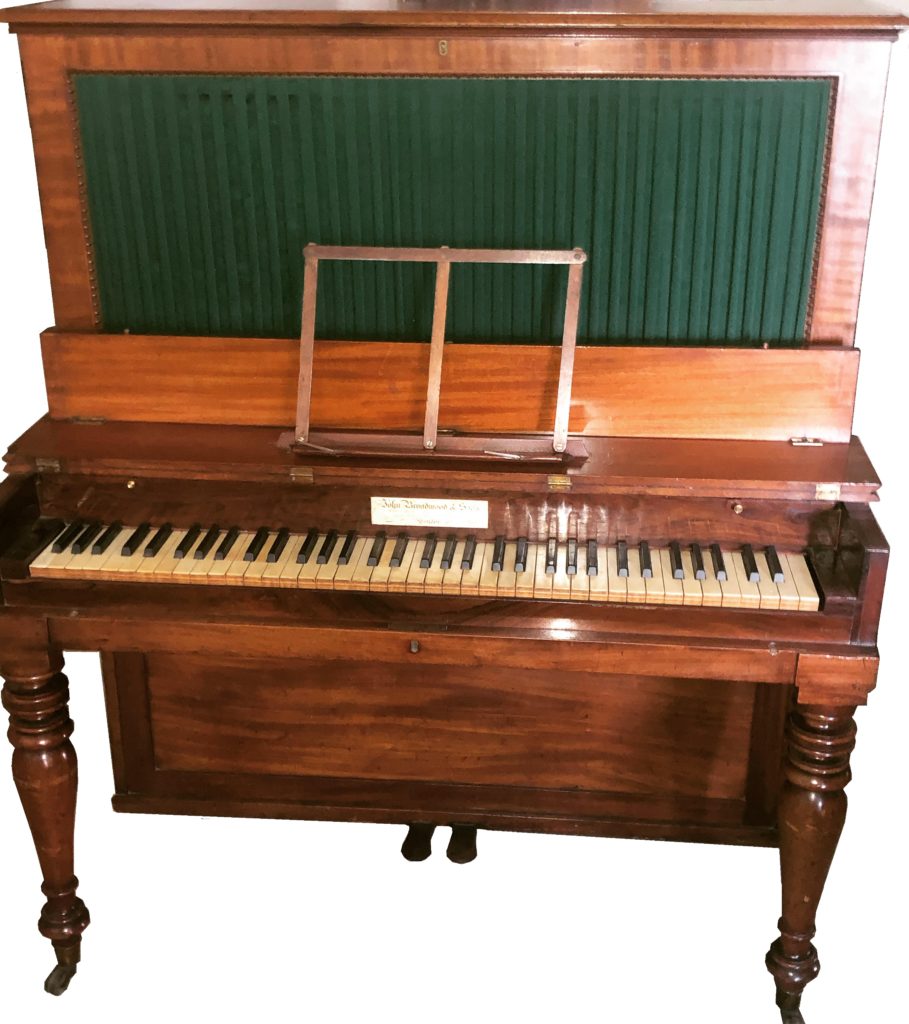Cottage Piano John Broadwood and Sons 1833
Description

| Date: | 1833 |
| Origin: | London |
| Serialnumber: | 1778 |
In addition to square and grand pianos, the long-established company John Broadwood & Sons in London also produced the new upright pianos that were fashionable at the beginning of the 19th century. These small Cottage Pianos were more space-saving than their larger relatives and enjoyed increasing popularity.
According to the serial number, this instrument was made in London in 1833. The case is made of solid mahogany and the front is decorated with green silk. The keyboard is made of ivory and ebony. At both ends of the keyboard there are two retractable platforms for candle holders that can be pulled out via a small ring. The instrument has two wooden pedals (dampers, “blind pedal” with no function) and a compass of 6 octaves (FF – f4). The hammers are covered with felt and the instrument is double strung with an English double action with abstracts. The nameboard is decorated with various inlays and bears the signature:
“John Broadwood and Sons. / Makers to his Majesty and the Princesses / Great Pulteney Street Golden Square London”
There is a second handwritten signature on the wrest plank: “H. B.” or “J. B.” (illegible) The serial number is 1778 and can also be found on the wrest plank.
The instrument comes from the former collection of Mary and Kenneth Mobbs in Bristol. According to records, the instrument was acquired from Rev. W. T. H. B. Davies on February 19, 1986. During the time in the possession of Mary and Kenneth Mobbs, the piano was loaned and exhibited at the Royal Academy of Music Museum.
John Broadwood was born on October 6, 1732 in Oldhamstocks near Cockburnspath in Scotland. He learned the trade of cabinet maker like his father had before. In 1761 he started working for Burkat Shudi (1702 – 1773) in London and became his business partner in 1770. In 1771 he opened his own shop on Great Pulteney Street in London. John Broadwood married Burkat Shudi’s daughter Barbara in 1769 and had four children with her. After the early death (1776) of his wife, he married Mary Kitson in 1781 and had six children with her. He died in London on July 17, 1812. (see: M. Clinkscale: Makers of the Piano 1700 – 1820, Oxford University Press 1999)
Other surviving instruments by John Broadwood & Sons:
1823 – Cottage Piano – David Brenner, Riverside USA
c. 1835 – Cottage Piano – Musée des Instruments de Musique, Brussels Belgium
c. 1840 – Cottage Piano – The Royal Academy of Music, London England
| Length: | 65,6 cm |
| Width: | 114,2 cm |
| Height: | 133,3 cm |
| Circumference: | 6 octaves (FF – f4) |
| Mechanics: | english double action with abstracts |
| Pedals: | 2 pedals (dampers, “blind pedal” with no function) |
| Signature: |
„John Broadwood and Sons. / Makers to his Majesty and the Princesses / Great Pulteney Street Golden Square London” |

